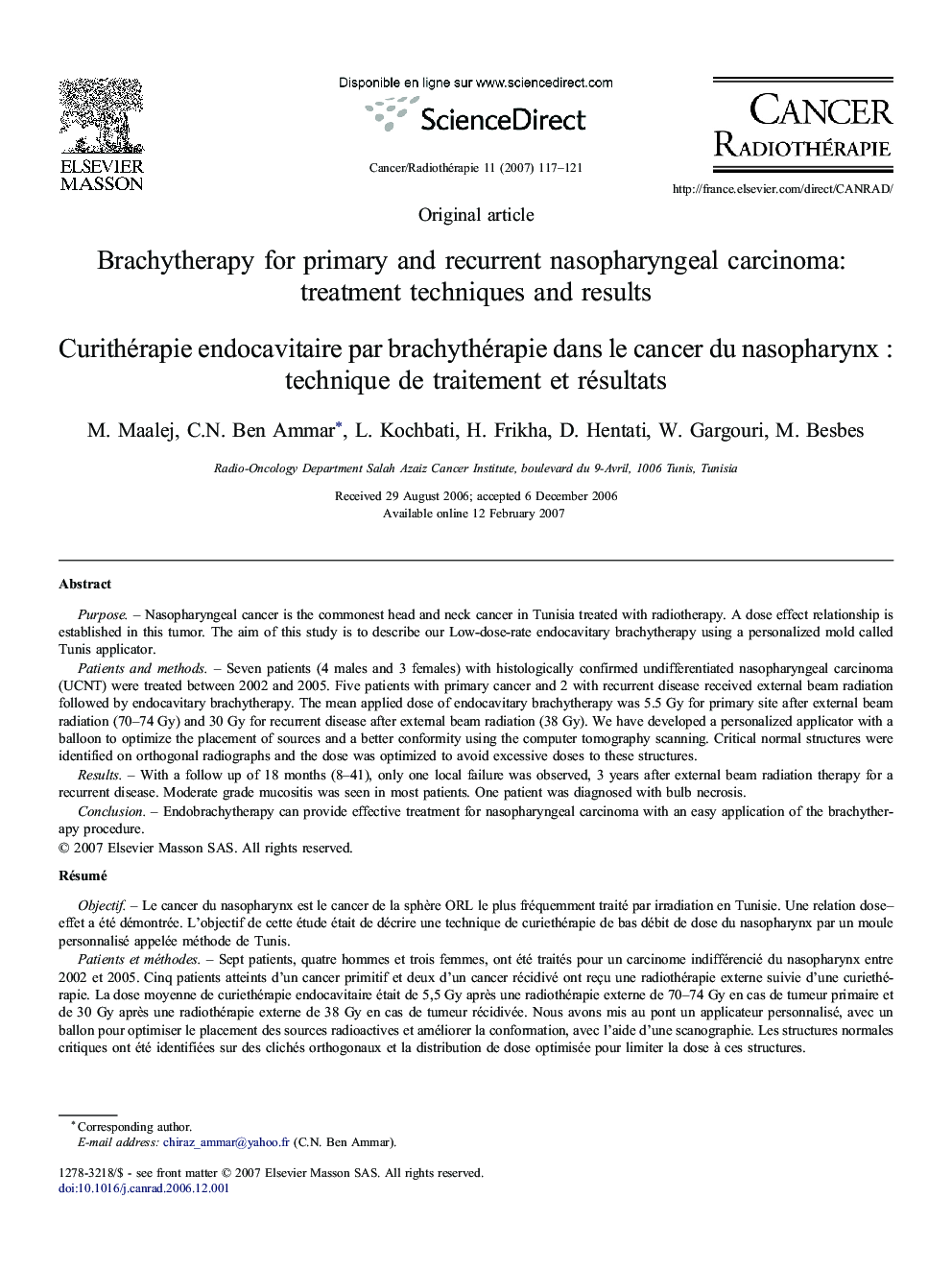| کد مقاله | کد نشریه | سال انتشار | مقاله انگلیسی | نسخه تمام متن |
|---|---|---|---|---|
| 2118915 | 1085258 | 2007 | 5 صفحه PDF | دانلود رایگان |

PurposeNasopharyngeal cancer is the commonest head and neck cancer in Tunisia treated with radiotherapy. A dose effect relationship is established in this tumor. The aim of this study is to describe our Low-dose-rate endocavitary brachytherapy using a personalized mold called Tunis applicator.Patients and methodsSeven patients (4 males and 3 females) with histologically confirmed undifferentiated nasopharyngeal carcinoma (UCNT) were treated between 2002 and 2005. Five patients with primary cancer and 2 with recurrent disease received external beam radiation followed by endocavitary brachytherapy. The mean applied dose of endocavitary brachytherapy was 5.5 Gy for primary site after external beam radiation (70–74 Gy) and 30 Gy for recurrent disease after external beam radiation (38 Gy). We have developed a personalized applicator with a balloon to optimize the placement of sources and a better conformity using the computer tomography scanning. Critical normal structures were identified on orthogonal radiographs and the dose was optimized to avoid excessive doses to these structures.ResultsWith a follow up of 18 months (8–41), only one local failure was observed, 3 years after external beam radiation therapy for a recurrent disease. Moderate grade mucositis was seen in most patients. One patient was diagnosed with bulb necrosis.ConclusionEndobrachytherapy can provide effective treatment for nasopharyngeal carcinoma with an easy application of the brachytherapy procedure.
RésuméObjectifLe cancer du nasopharynx est le cancer de la sphère ORL le plus fréquemment traité par irradiation en Tunisie. Une relation dose–effet a été démontrée. L'objectif de cette étude était de décrire une technique de curiethérapie de bas débit de dose du nasopharynx par un moule personnalisé appelée méthode de Tunis.Patients et méthodesSept patients, quatre hommes et trois femmes, ont été traités pour un carcinome indifférencié du nasopharynx entre 2002 et 2005. Cinq patients atteints d'un cancer primitif et deux d'un cancer récidivé ont reçu une radiothérapie externe suivie d'une curiethérapie. La dose moyenne de curiethérapie endocavitaire était de 5,5 Gy après une radiothérapie externe de 70–74 Gy en cas de tumeur primaire et de 30 Gy après une radiothérapie externe de 38 Gy en cas de tumeur récidivée. Nous avons mis au pont un applicateur personnalisé, avec un ballon pour optimiser le placement des sources radioactives et améliorer la conformation, avec l'aide d'une scanographie. Les structures normales critiques ont été identifiées sur des clichés orthogonaux et la distribution de dose optimisée pour limiter la dose à ces structures.RésultatsAvec un suivi en moyenne de 18 mois (8–41), il n'a été observé qu'une récidive locale, trois ans après la radiothérapie externe pour un cancer récidivant. Une mucite d'intensité modérée a été constatée chez tous les patients. Un patient a eu une nécrose bulbaire.ConclusionLa curiethérapie endocavitaire est un traitement efficace du cancer du nasopharynx et la méthode utilisée de réalisation facile.
Journal: Cancer/Radiothérapie - Volume 11, Issue 3, May 2007, Pages 117–121